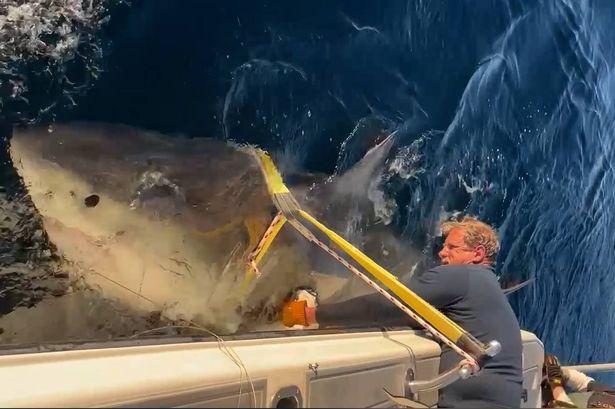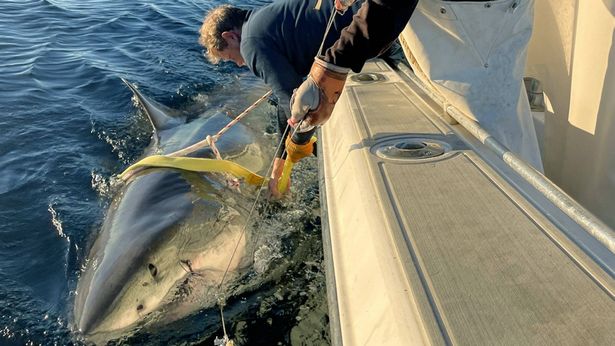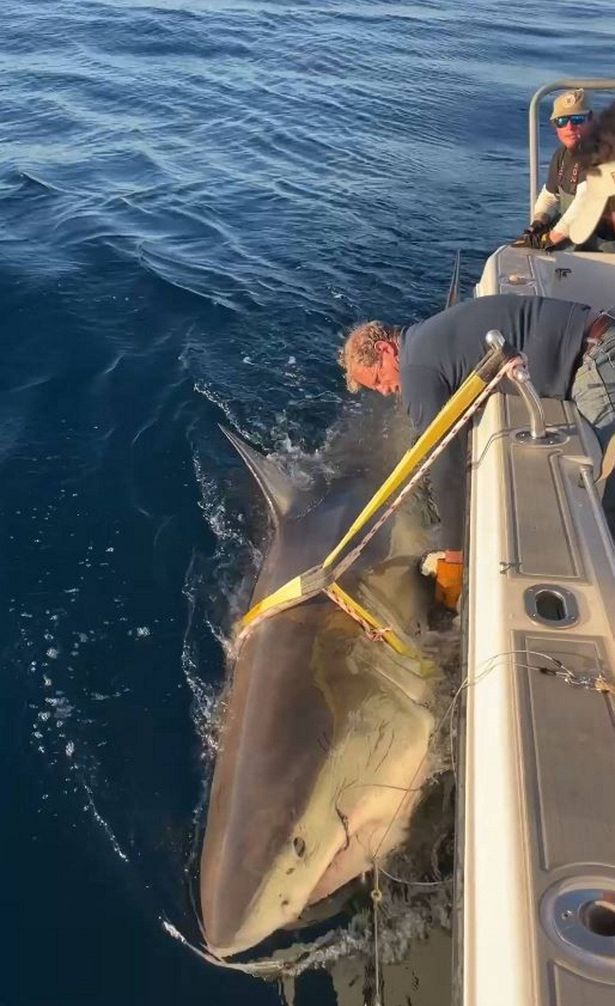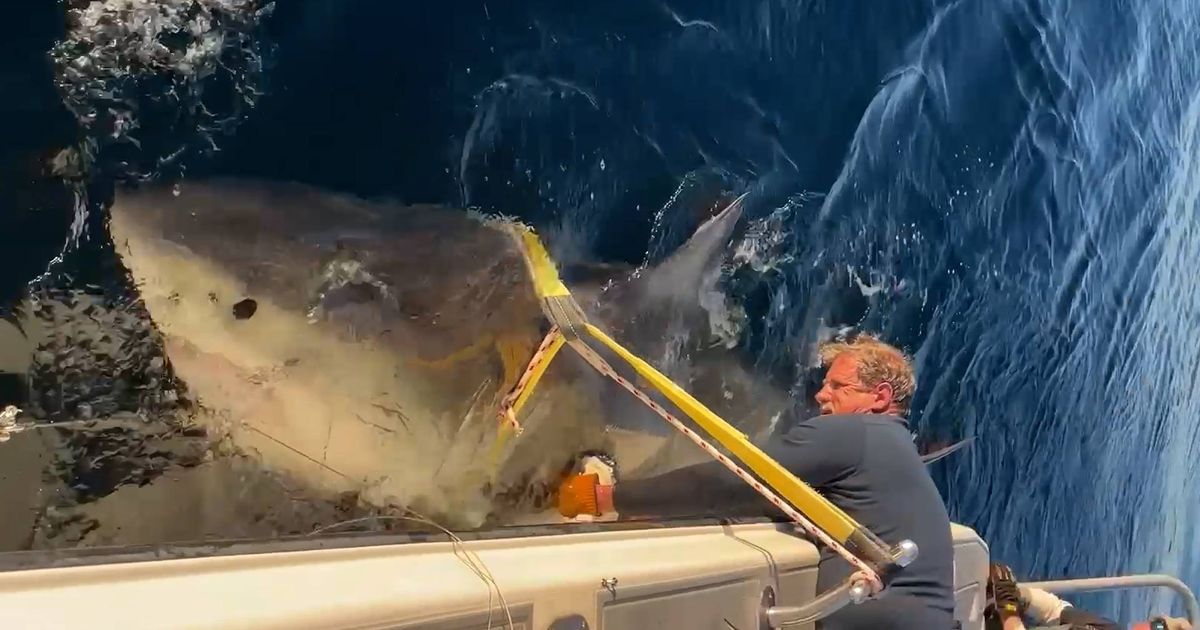The 14ft great white shark, nicknamed Contender, was tagged in the North Atlantic by OCEARCH in January and it is the biggest great white ever recorded in the Atlantic
10:47, 08 Oct 2025Updated 08:26, 09 Oct 2025
 The shark is the biggest great white recorded(Image: OCEARCH/SWNS)
The shark is the biggest great white recorded(Image: OCEARCH/SWNS)
The largest great white shark ever recorded in the Atlantic has emerged just off the Canadian coast – where he’s feasting on seals before winter arrives. Contender, a 14ft monster, was tagged in the North Atlantic by OCEARCH in January – a non-profit organisation that conducts research on large marine animals – 45 miles off the Florida-Georgia coast, off Jacksonville.
His tracker only transmits a locating signal when the shark’s dorsal fin is briefly exposed above the water’s surface. Last week it ‘pinged’ from the far northern reaches of the Gulf of St Lawrence, right off the Labrador Peninsula in Canada, making him “one of the furthest northern pinging sharks that we’ve had”, said researchers.
The 1,653lbs creature, estimated to be around 30 years old, is in the area devouring seals through summer and autumn, to pack on fat for his journey back to Florida in winter. Scientists at OCEARCH hope tracking Contender will reveal the world’s first known great white shark mating site. And if you are partial to reading about Chondrichthyes – then check out this face to fin moment or this jaw dropping encounter.
Chris Fischer, 56, founder and expedition leader of OCEARCH, said: “Only a couple have made it that far north. An animal like that, spending the summer and fall up north – what are they doing? Well, a lot of what they’re doing is preparing for the winter.”
Fischer explained that Contender is “putting a lot of pressure on the seals, eating seals constantly, swimming in front of seal colonies, trying to put on some weight before he proceeds back down to Florida for the oncoming winter”. He also noted this behaviour had an unexpected environmental benefit.
“The byproduct of putting that pressure on the seals is really good, they’re guarding our fish stocks,” Fischer said. “We know that if the white sharks are in front of the seals putting pressure on them, they eat one-fourth as much per day.
He added: “If that white shark’s not there, those seals go out and they wipe out all the fish.” Contender’s presence in such cold northern waters demonstrates the remarkable adaptability of great whites, he said.
 The biggest great white shark ever recorded is on the move(Image: OCEARCH/SWNS)
The biggest great white shark ever recorded is on the move(Image: OCEARCH/SWNS)
“White sharks have the capacity to warm themselves and be in cold water, but they have to have a lot of food,” Fischer said. “Like horses in winter – as long as they have food, they’re fine. If they run out of food, they freeze very quickly.”
Contender was tagged off the Florida-Georgia coast in January. After going off the radar for nearly a month, he pinged off Pamlico Sound in North Carolina twice in one day. Then he didn’t ping during a long journey up north, until he surfaced off Natashquan, Canada, on September 29.
There was a z-ping – when the shark spends only a brief period of time at the surface but not enough to determine an accurate location – on October 2. Tagged off the coast of Florida-Georgia in January, Contender is a beacon of hope for a population that was nearly wiped out decades ago.
“We decimated the shark population so badly in the 60s, 70s and 80s – we got down to nine percent of our population,” Fischer said. What makes Contender particularly valuable to researchers is his potential to unlock one of marine biology’s greatest mysteries.
“These big mature males are hugely important because they can help us understand where and when mating is occurring,” Fischer explained. Unlike females, which have complex two-year migratory cycles, “the male white sharks basically have their whole year revolve around mating,” he added.
The tracking data from Contender’s satellite tag, which will function for five years, could lead to an unprecedented scientific breakthrough. There’s never been a white shark mating site identified anywhere in the world in any one of the nine populations,” Fischer said. “It would be a first.”
 Contender, the 14ft great white shark(Image: OCEARCH/SWNS)
Contender, the 14ft great white shark(Image: OCEARCH/SWNS)
Fischer’s team is particularly focused on Contender’s movements in the coming months. The shark’s location next spring could provide crucial evidence for identifying mating grounds, with early data suggesting activity off the southeastern United States.
Despite his impressive size, Contender still has room to grow – potentially reaching over 20 feet in total. Fischer is particularly intrigued to see what Contender will look like “30 or 40 years from now,” noting the colossal creature is around 30 to 35 years old and can live to be over 70.
“It’ll be really interesting to watch Contender this year,” Fischer said. “I want to know where Contender will be in March of 2026, in April of 2026. I think that could be a massive clue for identifying where they mate.”

